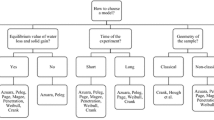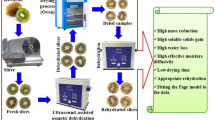Abstract
Peleg’s equation was used to study the effect of process parameters on kinetics of mass transfer in terms of solids gain and water loss during osmotic dehydration using 30–50% (w/w) sucrose solution at 30, 40 and 50 °C. The experimental data were successfully fitted employing Peleg’s equation with the coefficient of determination (R 2) higher than 0.88, the root mean square error, and the mean relative percentage deviation modulus (E) of less than 0.003% and 6.40% for all treatments, respectively. In all cases, initial mass transfer rate parameter (K 1) decreased significantly (p < 0.05) as the solution concentration and solution temperature increased suggesting a corresponding increase in the initial mass transfer rate. Initial mass transfer rate followed an Arrhenius relationship which showed that solids gain had the highest temperature sensitivity (E a = 21.93–33.84 kJ mol−1) during osmotic dehydration. Equilibrium mass transfer parameter (K 2) decreased significantly (p < 0.05) as solution concentration increased demonstrating that the equilibrium solid and water contents increased with increase in solution concentration. The equilibrium solid and water contents were also estimated adequately using Peleg’s equation (R 2 > 0.78). The results of this work allow estimating the kinetics of mass transfer during osmotic dehydration in order to obtain products with determined solid and water contents.



Similar content being viewed by others
Abbreviations
- E a :
-
Activation energy (kJ mol−1)
- k 0 :
-
Frequency factor (min−1)
- K 1 :
-
Peleg rate constant (min g/g−1)
- K 2 :
-
Peleg capacity constant (g/g)−1
- M :
-
Mass of sample (g) after time (t)
- m :
-
Dry mass of sample (g) after time (t)
- n :
-
Number of experimental data
- R :
-
Universal gas constant (8.314 kJ/mol K)
- SG:
-
Solid gain (g/g)
- T :
-
Absolute temperature (K)
- t :
-
Time (min)
- V :
-
Value
- WL:
-
Water loss (g/g)
- X :
-
Dependent variable
- ∞:
-
At equilibrium
- 0:
-
At the beginning of the process
- exp:
-
Experimental
- pre:
-
Predicted
References
Andrade, S. A. C., de Barros Neto, B., Nobrega, A. C., Azoubel, P. M., & Guerra, N. B. (2007). Evaluation of water and sucrose diffusion coefficients during osmotic dehydration of jenipapo (Genipa americana L.). Journal of Food Engineering, 78, 551–555.
AOAC. (1990). Official methods of analysis. Washington: Association of Official Analytical Chemists.
Askar, A., Abdel-Fadeel, M. G., Ghonaim, S. M., Abdel-Gaid, I. O., & Ali, A. M. (1996). Osmotic and solar dehydration of peach fruits. Fruit Processing, 9(1), 258–262.
Atarés, L., Chiralt, A., & González-Martínez, C. (2008). Effect of solute on osmotic dehydration and rehydration of vacuum impregnated apple cylinders (cv. Granny Smith). Journal of Food Engineering, 89(1), 49–56.
Azoubel, P. M., & Murr, F. E. X. (2004). Mass transfer kinetics of osmotic dehydration of cherry tomato. Journal of Food Engineering, 61, 291–295.
Bchir, B., Besbes, S., Karoui, R., Paquot, M., Attia, H., & Blecker, C. (2010). Osmotic dehydration kinetics of pomegranate seeds using date juice as an immersion solution Base. Food and Bioprocess Technology. doi:10.1007/s11947-010-0442-1. in press.
Chausi, B., Couture, F., & Roques, M. (2001). Modelling of multicomponent mass transport in deformable media. Application to dewatering impregnation soaking processes. Drying Technology, 19, 2081–2101.
Chenlo, F., Moreira, R., Fernandez-Herrero, C., & Vazquez, G. (2006). Experimental results and modeling of the osmotic dehydration kinetics of chestnut with glucose solutions. Journal of Food Engineering, 74, 324–334.
Corrêa, J. L. G., Pereira, L. M., Vieira, G. S., & Hubinger, M. D. (2010). Mass transfer kinetics of pulsed vacuum osmotic dehydration of guavas. Journal of Food Engineering, 96, 498–504.
Corzo, O., & Bracho, N. (2004). Effects of brine concentration and temperature on equilibrium distribution coefficients during osmotic dehydration of sardine sheets. Lebensmittel-Wissenschaft und Technologie, 37, 475–479.
Corzo, O., & Bracho, N. (2005). Osmotic dehydration kinetics of sardine sheets using Zugarramurdi and Lupín model. Journal of Food Engineering, 66, 51–56.
Corzo, O., & Bracho, N. (2006). Application of Peleg’s model to study mass transfer during osmotic dehydration of sardine sheets. Journal of Food Engineering, 75, 535–541.
Deng, Y., & Zhao, Y. (2008). Effects of pulsed-vacuum and ultrasound on the osmodehydration kinetics and microstructure of apples (Fuji). Journal of Food Engineering, 85, 84–93.
Eren, I., & Kaymak-Ertekin, F. (2007). Optimization of osmotic dehydration of potato using response surface methodology. Journal of Food Engineering, 79, 344–352.
Falade, K. O., Igbeka, J. C., & Ayanwuyi, F. A. (2007). Kinetics of mass transfer, and colour changes during osmotic dehydration of watermelon. Journal of Food Engineering, 80, 979–985.
Fermin, W. J., & Corzo, O. (2005). Optimization of vacuum pulse osmotic dehydration of cantaloupe using response surface methodology. Journal of Food Processing and Preservation, 29(1), 20–32.
García-Martínez, E., Martínez-Monzó, J., Camacho, M. M., & Martínez-Navarrete, N. (2002). Osmotic solution as ingredient in new product formulation. Food Research International, 35, 307–312.
Hawkes, J., & Flink, J. M. (1978). Osmotic concentration of fruit slices prior to freeze dehydration. Journal of Food Processing and Preservation, 2, 265–284.
Ispir, A., & Togrul, I. T. (2009). Osmotic dehydration of apricot: kinetics and the effect of process parameters. Chemical Engineering Research and Design, 87, 166–180.
Ito, A. P., Tonon, R. V., Park, K. J., & Hubinger, M. D. (2007). Influence of process conditions on the mass transfer kinetics of pulsed vacuum osmotically dehydrated mango slices. Drying Technology, 25(11), 1769–1777.
Khin, M. M., Zhou, W., & Perera, C. O. (2006). A study of the mass transfer in osmotic dehydration of coated potato cubes. Journal of Food Engineering, 77, 84–95.
Khoyi, M. R., & Hesari, J. (2007). Osmotic dehydration kinetics of apricot using sucrose solution. Journal of Food Engineering, 78(4), 1355–1360.
Le Maguer, M. (1988). Osmotic dehydration: review and future directions. International symposium progress in food preservation processes, Ceria, Brussels, Belgium
Lenart, A., & Flink, S. M. (1984). Osmotic concentration of potato I. Criteria for the end point of the osmosis process. Journal of Food Technology, 19, 65–89.
Madamba, P. S. (2003). Thin layer drying models for osmotically predried young coconut. Drying Technology, 21, 1759–1780.
Mastrantonio, S. D. S., Pereira, L. M., & Hubinger, M. D. (2005). Osmotic dehydration kinetics of guavas in maltose solutions with calcium salt. Alimentos e Nutrição, 16, 309–314.
Mayor, L., Moreira, R., Chenlo, F., & Sereno, A. M. (2006). Kinetics of osmotic dehydration of pumpkin with sodium chloride solutions. Journal of Food Engineering, 74, 253–262.
Moreira, R., Chenlo, F., Torres, M. D., & Vazquez, G. (2007). Effect of stirring in the osmotic dehydration of chestnut using glycerol solutions. LWT Food Science and Technology, 40, 1507–1514.
Palou, E., Lopez-Malo, A., Argaiz, A., & Welti, J. (1993). Osmotic dehydration of papaya: effect of syrup concentration. Revista Espanola de Ciencia e Tecnologia de Alimento, 33(6), 621–630.
Panades, G., Fito, P., Aguiar, Y., Nunez de Villavicencio, M., & Acosta, V. (2006). Osmotic dehydration of guava: influence of operating parameters on process kinetics. Journal of Food Engineering, 72, 383–389.
Panades, G., Castro, D., Chiralt, A., Fito, P., Nuñez, M., & Jimenez, R. (2008). Mass transfer mechanisms occurring in osmotic dehydration of guava. Journal of Food Engineering, 87(3), 386–390.
Panagiotou, N. M., Karathanos, V. T., & Maroulis, Z. B. (1999). Effect of osmotic agent on osmotic dehydration of fruits. Drying Technology, 17(1/2), 175–189.
Parjoko, M., Rahman, S., Buckle, K. A., & Perera, C. (1996). Osmotic dehydration kinetics of pineapple wedges using palm sugar. Lebensmittel-Wissenschaft und-Technolgie, 29, 452–459.
Peleg, M. (1988). An empirical model for the description of moisture sorption curves. Journal of Food Science, 53(4), 1216–1218.
Pokharkar, S. M. (2001). Kinetic model for osmotic dehydration of green peas prior to air-drying. Journal of Food Science and Technology, 38(6), 557–560.
Prothon, F., Ahrne, L. M., Funebo, T., Kidman, S., Langton, M., & Sjoholm, I. (2001). Effects of combined osmotic and microwave dehydration of apple on texture, microstructure and rehydration characteristics. Lebensmittel-Wissenschaft und Technologie, 34, 95–101.
Rahman, M. S., & Lamb, J. (1990). Osmotic dehydration of pineapple. Journal of Food Science and Technology, 27, 150–152.
Rastogi, N. K., & Raghavarao, K. S. M. S. (2004). Mass transfer during osmotic dehydration of pineapple: considering Fickian diffusion in cubical configuration. Lebensmittel-Wissenschaft und Technologie, 37, 43–47.
Rastogi, N. K., Raghavarao, K. S. M. S., Niranjan, K., & Knorr, D. (2002). Recent developments in osmotic dehydration: methods to enhance mass transfer. Trends in Food Science and Technology, 13(2), 58–69.
Ruiz-López, I., Castillo-Zamudio, R. I., Salgado-Cervantes, M. A., Rodríguez-Jimenes, G. C., & García-Alvarado, M. A. (2008). Mass transfer modeling during osmotic dehydration of hexahedral pineapple slices in limited volume solutions. Food and Bioprocess Technology. doi:10.1007/s11947-008-0102-x. in press.
Sablani, S. S., Rahman, M. S., & Al-Sadeiri, D. S. (2002). Equilibrium distribution data for osmotic drying of apple cubes in sugar-water solution. Journal of Food Engineering, 52, 193–199.
Sachetti, G., Gianotti, A., & Dalla Rosa, M. (2001). Sucrose-salt combined effects on mass transfer kinetics and product acceptability. Study on apple osmotic treatments. Journal of Food Engineering, 49, 163–173.
Sagar, V. R. (2001). Preparation of onion powder by means of osmotic dehydration and its packaging and storage. Journal of Food Science and Technology, 38(5), 525–528.
Shi, J., Pan, Z., McHugh, T., & Hirschberg, E. (2009). Effect of infusion method and parameters on solids gain in blueberries. Food and Bioprocess Technology, 3, 271–278.
Singh, B., Kumar, A., & Gupta, A. K. (2007). Study of mass transfer kinetics and effective diffusivity during osmotic dehydration of carrot cubes. Journal of Food Engineering, 79, 471–480.
Sutar, P. P., & Gupta, D. K. (2007). Mathematical modeling of mass transfer in osmotic dehydration of onion slices. Journal of Food Engineering, 78(1), 90–97.
Tortoe, C., Orchard, J., & Beezer, A. (2007). Osmotic dehydration kinetics of apple, banana and potato. International Journal of Food Science & Technology, 42, 312–318.
Uddin, B. M., Ainsworth, P., & Ibanoglu, S. (2004). Evaluation of mass exchange during osmotic dehydration of carrots using response surface methodology. Journal of Food Engineering, 65, 473–477.
Uribe, E., Miranda, M., Vega-Gálvez, A., Quispe, I., Clavería, R., & Di Scala, K. (2010). Mass transfer modelling during osmotic dehydration of jumbo squid (Dosidicus gigas): influence of Temperature on Diffusion Coefficients and Kinetic Parameters. Food and Bioprocess Technology. doi:10.1007/s11947-010-0336-2.
Acknowledgments
The authors are grateful for the financial support received from the Ministry of Higher Education through the Fundamental Research Grant Scheme (FRGS) and Universiti Putra Malaysia for this project.
Author information
Authors and Affiliations
Corresponding author
Rights and permissions
About this article
Cite this article
Ganjloo, A., Rahman, R.A., Bakar, J. et al. Kinetics Modeling of Mass Transfer Using Peleg’s Equation During Osmotic Dehydration of Seedless Guava (Psidium guajava L.): Effect of Process Parameters. Food Bioprocess Technol 5, 2151–2159 (2012). https://doi.org/10.1007/s11947-011-0546-2
Received:
Accepted:
Published:
Issue Date:
DOI: https://doi.org/10.1007/s11947-011-0546-2




